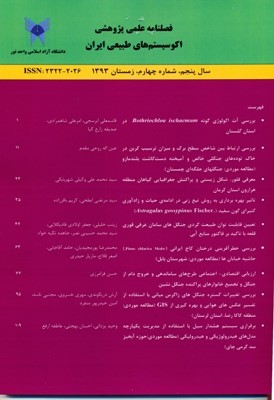تعیین قابلیت توان طبیعت گردی جنگل های سامان عرفی قوری قلعه با تاکید بر فاکتور منابع آبی
محورهای موضوعی : جنگلداریزینب خلیلی 1 , جعفر اولادی قادیکلایی 2 , سید محمد حسینی نصر 3 , جاهده تکیه خواه 4 *
1 - کارشناس ارشد جنگلداری، دانشکده منابع طبیعی، دانشگاه کشاورزی و منابع طبیعی ساری، مازندران، ایران
2 - عضو هیئت علمی گروه جنگلداری دانشکده منابع طبیعی، دانشگاه کشاورزی و منابع طبیعی ساری، مازندران، ایران
3 - عضو هیئت علمی گروه جنگلداری دانشکده منابع طبیعی، دانشگاه کشاورزی و منابع طبیعی ساری، مازندران، ایران
4 - دانشجوی دکترای جنگلداری، دانشکده منابع طبیعی و علوم دریایی دانشگاه تربیت مدرس، نور، ایران
کلید واژه: سیستم اطلاعات جغرافیایی, ارزیابی, طبیعتگردی, توان تفرجی, آمایش, پارک جنگلی,
چکیده مقاله :
چکیده ارزیابی توان طبیعت گردی به معنای تعیین قابلیت سرزمین برای کاربری اکوتوریسم و تفرج است. با توجه به اهمیت پارک جنگلی ارزیابی توان طبیعت گردی و شناسایی محدوده های مستعد تفرجی در آنها ضروری و لازم است. در این تحقیق با استفاده از مدل تجزیه و تحلیل سیستمی و سیستم اطلاعات جغرافیایی، مناطق مناسب برای طرح های گردشگری و طبیعت گردی در سامان عرفی قوری قلعه واقع در شمال غربی شهرستان پاوه با مساحت 46/2498 هکتار شناسایی شد. نتایج حاصل نشان داد منطقه مورد مطالعه فاقد تفرج متمرکز طبقه یک است. 29درصد مساحت منطقه توان تفرج طبقه دو، 38 درصد مساحت منطقه توان تفرج گسترده طبقه یک و توان تفرج گسترده طبقه دو 33 درصد از مساحت منطقه مورد مطالعه را در برمی گیرد. به منظور بررسی تأثیر منابع آبی بر تفرج در منطقه از روش دلفی استفاده شد. به این منظور تعداد 100 پرسشنامه بین گردشگران در شهرستان کرمانشاه و سامان عرفی قوری قلعه توزیع شد. نتایج حاصل از این ارزیابی نشان داد نوع و درجات مختلف تفرج به منابع آبی بستگی دارد. به منظور بررسی تأثیر فاکتور منابع آبی بر تفرج، نقشهبافرمنابع آبی تهیه شد و با نقشه توان تفرجی اولیه (حاصل از مدل تجزیه و تحلیل سیستمی) تلفیق و نقشه توان تفرجی نهایی بدست آمد. نتایج ارزیابی توان تفرجی نهایی نشان داد 6 درصد از مساحت منطقه توان تفرج متمرکز طبقه یک، 28 درصد از مساحت منطقه توان تفرج متمرکز طبقه دو، 35 درصد مساحت منطقه توان تفرج گسترده طبقه یک و توان تفرج گسترده طبقه دو 31 درصد مساحت منطقه را در برمی گیرد. با انجام این کار و مقایسه بین دو نقشه توان تفرجی اولیه و نهایی، تأثیرگذاری فاکتور منابع آبی در توان تفرجی منطقه مشخص شد. این نتایج بیانگر این مطلب است که فاکتور منابع آبی نسبت به فاکتورهای فیزیکی بیشترین تأثیر بر فرآیند ارزیابی توان تفرجی در منطقه مورد مطالعه را دارد.
Abstract: Evaluation of ecotourism capability is mean the identify of land capability for recreation and tourism landuse with attention to importance of forest park, is necessary evaluation of recreation potential and identify of suitable regions for recreation usage. In this study, The appropriate areas for tourism and ecotourism plans were identified in Ghoori Ghale area located at North western of Paveh with an area of 2498/46 ha Using GIS and systematic analysis model .Based on the result, No class1 mass ecotourism existed in the study area. Twenty nine percent of the area were potential for class2 alternative ecotourism 38% for class1 alternative ecotourism and 33% for alternative ecotourism.To deter mine the importance of available water resources on tourism development, Delphi method was used. For this, 100 questionnaire were distributed among tourists in Kermanshah and Ghoori Ghale area. Based on the obtained result, different type and degrees of ecotourism depend on the available water resource. To measure the effects water resource factor on ecotourism and also to enhance the systematic analysis model, The map of water resources were prepared then this map was combined with primary ecotourism potential map (obtained using systematic analysis model) to produce the final ecotourism potential map. Result of ecotourism potential evaluation showed that 6%, 28%, 35%, and 31% of the study area are appropriate for class 1 mass ecotourism, class 2 mass ecotourism, class1 alternative ecotourism and class 2 alternative ecotourism, respectively. Then, Comparison were made between the primary and final ecotourism potential maps to identify the effects of water resource on ecotourism potential of the area. Our findings showed higher effects water resource factor rather than physical factors
References
1-Fennel, D., 1999. Ecotourism and introduction. First published Rout ledge is an imprint of the taylor& francis Group. 314 pp.
2-Gülez, S., O. Demirel, 2004. An evaluation method for the determination for forest recreation potential: a case study. Countryside Recreation, 12: 26-34.
3-Ghannadkar Sarabi, M., 1999. Forest park designing and management forest and rangelands organization, forestry and parks office. 73PP.
4-Hathout, S., 2002. The use of GIS for monitoring and predicting urban growth in East and West st paul, Winnipeg, Manitoba, Canada. J. Environ. Manage, 66: 229- 238
5-Mahmodi,b., 2006. . evaluating the recreational potential Case Study Mange area inLordegan. MSC. Thesis, forestry, University of agricultural science and Natural resources, Sari, 121PP.
6-Makhdom, M., 2006. Land preparation infrastructure. Tehran University publication.P289.
7-Manocheri, M., 2006.Ecotourism Assessment of Naharkhoran Region Using RS and GIS. Msc. Thesis. University of agricultural science and Natural resources, sari. 90PP.
8-Obua, J., D.M. Harding, 1997.Environmental impact of ecotourism in Kibal National Park, Uganda. Journal of Sustainable Tourism, 10:213-223
9-Quangminh,V., Quang tri, and Yamada. 2003. Delination and incorpotatian of socio- infrastructure database into GIS for land use planning: Acase study of Tan phu Thanh Village, Chauthanh district ,Cantho Province, Map Asia Conference, GIS development. Net, 14.PP
10-Skandari, S., 2008. evaluating the recreational potential of SorkheHesar forest park Using GIS. MSC. Thesis, forestry, University of agricultural science and Natural resources, Sari, 112PP.
11-Tahery, F., 2005.Assessing the potential Area for ecotourism Using GIS and RS. Msc. Thesis. University of agricultural science and Natural resources, sari. 100PP.
12-Tekiekhah, y., 2008. Studying the recreational potential of Abidar forest Park Using GIS. Msc. Thesis. University of agricultural science and Natural resources, sari. 86PP.
13 Tsaur, Sh., Y. Lin, J. Lin, 2005. Evaluating ecotourism sustainability from the integrated perspective of resource. Community and Tourism Management: 640-653.

